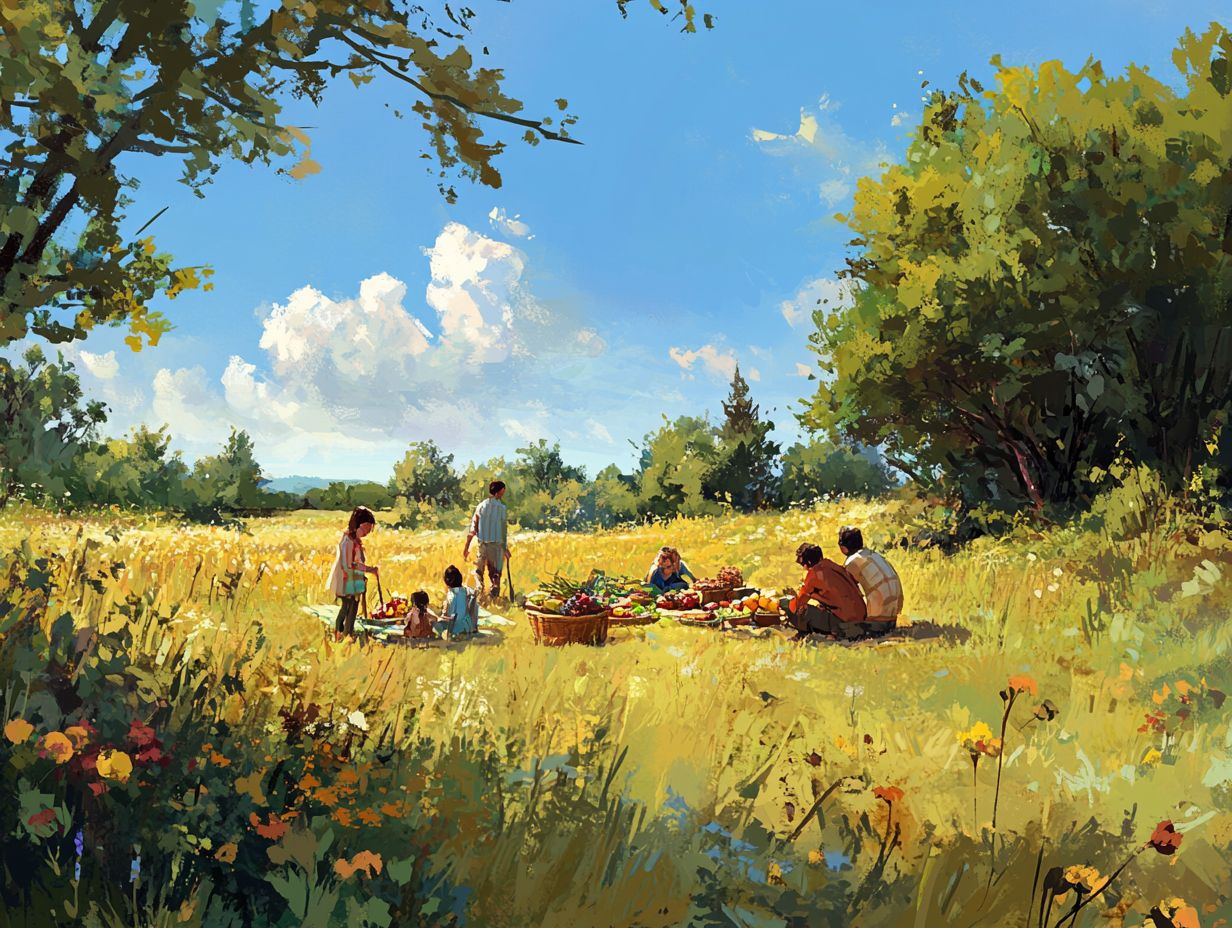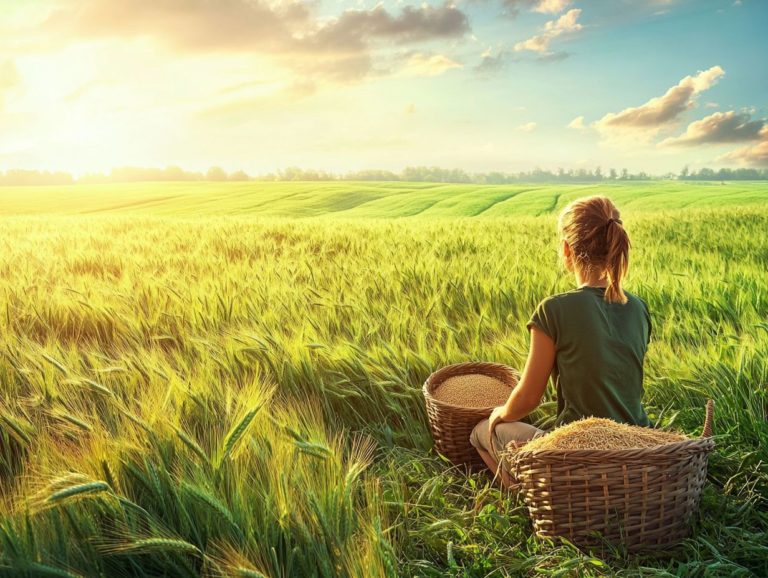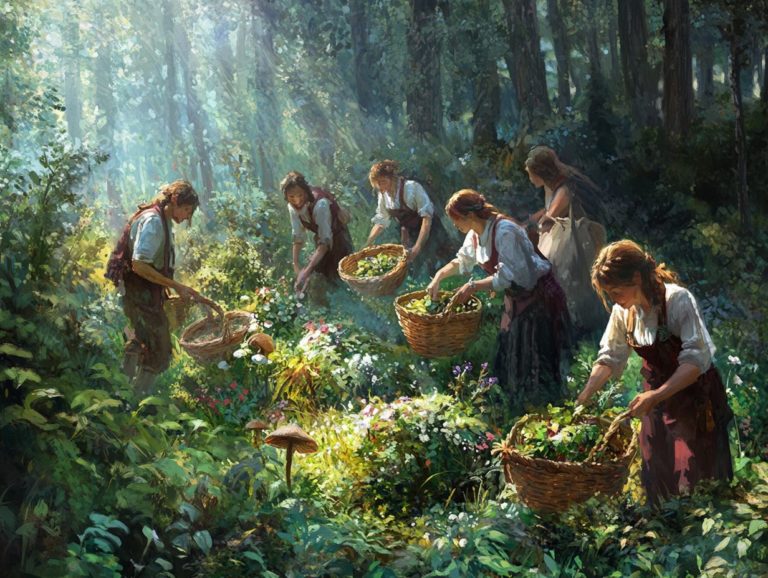Foraging Techniques for Picnic Adventures
Foraging transcends mere trend; it offers you a profound connection with nature, allowing you to unearth delightful wild ingredients right in your own backyard.
This guide explores the many benefits of foraging for your picnic adventures, emphasizing its nutritional gains and environmental impact. You will discover essential safety and ethical guidelines, along with the tools necessary for your foraging journey and tips to identify edible plants and fungi.
You will find inventive recipes that celebrate your foraged treasures. Jump in and discover the forager within you!
Contents
- Key Takeaways:
- Benefits of Foraging for Picnics
- Foraging Safety and Ethics
- Foraging Tools and Supplies
- Identifying Edible Plants and Fungi
- Foraging Techniques and Tips
- Recipes and Ideas for Foraged Picnic Meals
- Frequently Asked Questions
- What are foraging techniques for picnic adventures?
- Why should I use foraging techniques for picnic adventures?
- Where can I forage for food for my picnic adventure?
- What are some safety precautions to take when foraging for a picnic adventure?
- What are some common types of food that can be foraged for a picnic adventure?
- Can picking wild foods on picnic adventures be environmentally friendly?
Key Takeaways:

- Incorporate foraging into your picnic adventures for nutritional and environmental benefits, engaging in community exploration and local herbalist workshops.
- Ensure your safety and the sustainability of the environment by following guidelines and using essential gear while foraging.
- Expand your culinary horizons with expert tips for identifying and harvesting wild foods, and try delicious foraged picnic meals.
What is Foraging?
Foraging is your gateway to a world of wild plants, mushrooms, and other edible treasures just waiting to be discovered in their natural habitats. It s not just about gathering food. It s a profound connection with nature that nurtures environmental stewardship and deepens your relationship with the local landscape.
Many enthusiasts, like yourself, hone their skills through identification courses and workshops led by knowledgeable herbalists. They emphasize the importance of sustainable harvesting practices, which means taking only what you need and leaving some for nature. As urban foraging gains traction, communities are coming together to explore a diverse array of wild food resources that are both nutritious and beneficial for health and well-being.
Historically, foraging was a matter of survival, with ancient cultures relying on wild edibles as their primary food source. Today, you might find yourself seeking out familiar wild plants like dandelions and nettles, or foraging for delectable mushrooms such as chanterelles and morels. This enriches your experience with local knowledge from herbalists.
Safety is paramount, so having proper identification skills and knowledge of poisonous species is crucial. Many choose to rely on experienced guides to navigate this exciting venture safely. The rise of wild food tourism offers a chance to delve into gourmet culinary applications of foraged ingredients, enriching your understanding of local ecosystems. This burgeoning interest not only fosters a sense of community but also encourages a deeper appreciation for the land s abundant offerings.
Benefits of Foraging for Picnics
Foraging for wild plants and mushrooms offers you a unique culinary adventure, elevating your outdoor meals with fresh, nutrient-rich ingredients. Imagine adding dandelions, nettles, or ramps to your picnic spread. To enhance your foraging experience, learning how to develop your own foraging techniques can deepen your connection to the local landscape and the shifting seasons while uncovering these edible treasures that not only enhance the flavors.
Engaging in foraging activities invites community participation, creating a shared experience that cultivates a profound appreciation for nature s abundant offerings and fosters wildlife conservation efforts.
We invite you to share your foraging experiences or favorite foraged recipes with others!
Nutritional and Environmental Advantages
The nutritional and environmental benefits of foraging are truly remarkable. Exploring the world of wild edible plants and mushrooms unlocks a treasure trove of health benefits, rich in vitamins, minerals, and antioxidants.
By harvesting local produce, you play a vital role in supporting sustainable practices. This ensures minimal impact on the environment and promotes biodiversity (the variety of life in the world), which is essential for a balanced ecosystem.
Foraging deepens your connection to natural cycles and the study of nature s seasonal changes, fostering appreciation and commitment to conserving your local ecosystems.
Consider the delights of foraged treasures like dandelions and wild strawberries. Dandelions are not just weeds; they are packed with vital nutrients, including high levels of vitamins A, C, and K, and they significantly support liver health.
Wild strawberries satisfy your sweet cravings while providing powerful antioxidants that boost your immunity.
Engaging in foraging cultivates a sense of responsibility towards preserving nature. This connects you to your surroundings and encourages mindful consumption, especially as a beginner forager.
As communities embrace this practice, you nourish yourself while contributing to wildlife conservation, heightening awareness and respect for natural habitats.
Foraging Safety and Ethics
Foraging safety and ethics are crucial for a rewarding experience! Understanding these principles ensures you gather wild edible plants and mushrooms safely.
By adhering to foraging guidelines, you safeguard your health through proper identification practices and cultivate respect for local ecosystems.
This includes managing invasive species and ensuring that your harvesting methods are sustainable.
Engaging in identification courses and learning from local herbalists through hands-on activities can significantly enhance your skills and knowledge, making your foraging experience a safe and rewarding adventure.
Guidelines for Safe and Sustainable Foraging

Guidelines for safe and sustainable foraging are vital for you as a beginner eager to explore wild food resources. By following established safety precautions like proper identification and familiarization with local ecosystems you protect yourself and contribute to the conservation of edible plants and fungi.
Essential tools like a foraging journal, a reliable knife, a sturdy basket, and comprehensive field guides enhance your experience and help you gather and document your discoveries.
Engaging with local herbalists and participating in hands-on activities will provide valuable insights into which tools are best suited for foraging a variety of wild plants and mushrooms.
To differentiate between edible and toxic species, invest time in studying reputable field guides and join local foraging groups. The shared knowledge can prove invaluable.
Implementing sustainable harvesting techniques, such as taking only what you need and ensuring there s enough left for regeneration, helps preserve biodiversity. By understanding the seasonal cycles of plants, you cultivate respect for nature and foster a deeper connection with your environment.
Resources like workshops, online forums, and community foraging events offer continuous learning opportunities. Consider taking foraging classes and herbalist workshops to engage with others while reinforcing your commitment to safe and sustainable practices.
Foraging Tools and Supplies
Equipping yourself with the right foraging tools and supplies is essential for a successful outing, especially when you re venturing into the great outdoors.
Key items like a foraging journal, a reliable knife, a sturdy basket, and comprehensive field guides can greatly enhance your experience. They make it easier to gather and document your discoveries.
Start your foraging journey today and discover the bounty nature offers!
Essential Gear for Successful Foraging
Having the right gear will take your foraging experience to the next level! Essential items include sturdy bags for transporting your finds, reliable plant identification guides, and efficient harvesting tools. These are important whether you re just starting out or you re an experienced wild crafter.
Effective foraging isn t just about knowledge; it s about equipping yourself with the right tools to ensure safety and efficiency as you prepare outdoor meals and engage in wild food tourism, which means exploring and enjoying food sourced from nature.
To truly enhance your foraging escapades, selecting the right foraging knives is imperative. Their sharp blades will allow you to cleanly cut through various plants without causing damage. Gloves are also essential they protect your hands from thorns and poisonous plants while giving you a solid grip on your tools.
If you re venturing into berry picking, lightweight containers are a game changer. They help prevent your precious finds from getting squashed and ensure an optimal harvest.
Participating in local identification courses is incredibly beneficial for learning about safe species. Joining community explorations can foster teamwork and create shared experiences in uncovering nature’s edible treasures.
Identifying Edible Plants and Fungi
Identifying edible plants and fungi is an essential skill for anyone diving into the world of foraging. It directly influences both the safety and quality of the resources you gather, including understanding the nuances of wild crafters.
Taking part in identification courses can greatly enhance your ability to distinguish between delightful edibles, such as wild strawberries, and the potentially harmful species lurking nearby. Familiarizing yourself with local landscapes and being attuned to seasonal changes are equally vital for successful foraging. This ensures you know precisely when to seek out those culinary treasures.
Commonly Found Species and How to Identify Them
Commonly found species like dandelions, nettles, and ramps are staples in the foraging community. Each boasts unique identification markers that make them relatively easy for you to recognize. Mastering the art of accurately identifying these plants is essential for ensuring safe consumption and maximizing the potential of wild food resources.
With a detailed understanding of their habitats, seasonal appearances, and culinary uses, you can enrich your foraging experience and ignite your creativity in outdoor meals.
Take dandelions, for instance. Often spotted in lawns and meadows, they flaunt bright yellow flowers and serrated leaves, ready to be harvested year-round. Nettles, on the other hand, thrive in moist, shaded areas, with tender young shoots that are nutrient powerhouses. A little cooking or drying removes their sting, transforming them into a delightful addition to soups.
Ramps flourish in woodlands come spring, showcasing broad green leaves and a distinct, garlicky aroma that elevates a variety of dishes. Understanding their local growing conditions not only aids in identification but also enhances your preservation methods, allowing you to savor a bounty of flavors throughout the seasons.
Foraging Techniques and Tips

Mastering the art of foraging techniques and tips is crucial for anyone looking to excel in gathering wild plants and mushrooms, particularly when it comes to crafting unforgettable outdoor meals.
By honing practical strategies like recognizing the optimal times for foraging, tapping into local flora knowledge, and embracing the joys of wild food tourism you can elevate your experience to new heights.
Sharing these adventures through community exploration deepens your connection with nature and promotes sustainable practices that benefit everyone involved.
Get out there and start foraging today! Discover the joy of gathering fresh, wild ingredients.
Expert Tips for Finding and Harvesting Wild Foods
Expert tips for finding and harvesting wild foods can transform your foraging experience. This can turn an ordinary outing into a rewarding adventure filled with culinary delights. Key strategies include knowing when and where to seek specific plants, understanding the growing conditions that favor their growth, and practicing ethical harvesting methods to ensure sustainability.
Engaging with community members and local herbalists can further enrich your knowledge and skills. This amplifies the health benefits that foraging has to offer.
By employing the right tools think foraging baskets and field guides you can streamline the process of identifying and collecting edible plants. It s essential to familiarize yourself with various harvesting techniques. This allows you to minimize ecological impact while maximizing yield.
Sharing your experiences with fellow foragers can lead to valuable insights and foster camaraderie. You may even discover unique recipes that celebrate the nutritional benefits of wild ingredients. This collaborative spirit enhances your culinary applications and deepens your appreciation for the natural world, promoting a culture of sustainable foraging.
Recipes and Ideas for Foraged Picnic Meals
Crafting recipes and ideas for foraged picnic meals offers a unique opportunity to highlight the rich diversity of wild edible plants, and learning foraging techniques for wild game can further ignite your creativity and deepen your connection to nature.
By incorporating ingredients like dandelions, nettles, and wild mushrooms, you can create delectable dishes that celebrate the bounty of the season. Embracing techniques such as pickling and food preservation enhances your culinary repertoire. It also allows you to relish your foraged treasures long after the season has faded.
Tasty Dishes Using Foraged Ingredients
Delicious dishes crafted from foraged ingredients can elevate your picnic experience. They offer unique flavors that highlight the beautiful connection between food and nature. By learning foraging techniques for urban environments, you can imagine transforming ordinary meals into culinary masterpieces with wild green salads or rich mushroom risottos.
By employing diverse cooking techniques like saut ing, pickling, and baking, you can celebrate the seasonal offerings of your local landscape. Enjoy delightful outdoor meals with family and friends.
Exploring the culinary possibilities of foraged ingredients adds an adventurous twist to your everyday cooking. It fosters a deeper appreciation for seasonal biodiversity. For instance, experimenting with wild herbs such as fiddleheads in a creamy pasta dish or crafting refreshing teas from gathered flowers can breathe new life into traditional recipes.
Mindful preparation methods, like fermenting (a process that involves encouraging the growth of good bacteria) nettles or grilling ramps, enhance textures and flavors. They invite your creativity to take center stage.
Each meal you craft outdoors becomes a celebration. The fresh air and natural setting amplify the experience, encouraging you to savor the exquisite tastes of nature s bounty.
Frequently Asked Questions
What are foraging techniques for picnic adventures?

Foraging techniques for picnic adventures involve finding and gathering food from nature, such as wild plants, fruits, and nuts, to use for a picnic meal. For those interested, foraging in national parks can enhance your experience with valuable tips and techniques.
Why should I use foraging techniques for picnic adventures?
Using foraging techniques for seasonal delights during picnic adventures allows you to connect with nature and discover new flavors and ingredients for your picnic meals.
Where can I forage for food for my picnic adventure?
You can forage for food for your picnic adventure in various places, such as parks, forests, and even your own backyard, by utilizing foraging techniques for wilderness survival.
What are some safety precautions to take when foraging for a picnic adventure?
When foraging for a picnic adventure, it is important to properly identify any plants or fruits before consuming them. Additionally, learning how to use foraging techniques in cooking can enhance your experience. Avoid areas that may have been sprayed with chemicals.
What are some common types of food that can be foraged for a picnic adventure?
Some common types of food that can be foraged for a picnic adventure include berries, mushrooms, and edible greens like dandelion and wild spinach. Learning foraging techniques for sustainable eating can enhance your outdoor culinary experience.
Share your own foraging experiences or recipes in the comments below! Let’s foster a community that celebrates the joys of foraging!
Can picking wild foods on picnic adventures be environmentally friendly?
Yes! Picking wild foods on your picnic can be eco-friendly and fun. For summer foraging essentials, just remember to take only what you need and leave enough so nature can thrive.






